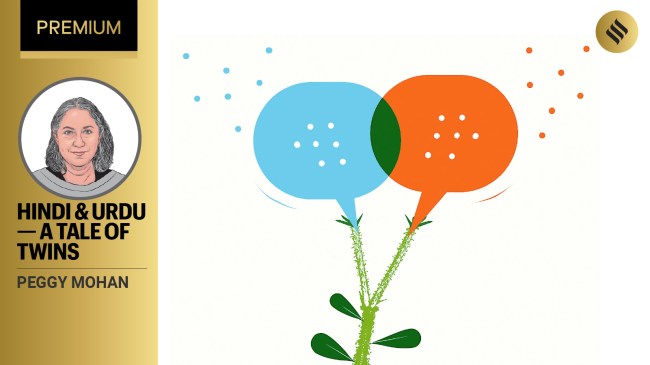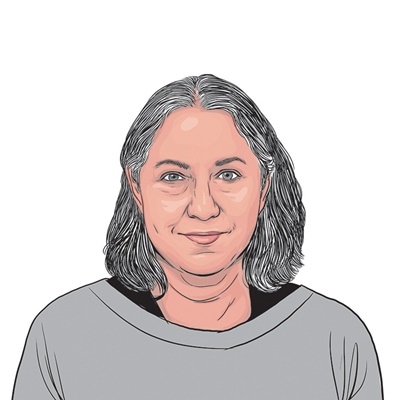Opinion Hindi and Urdu — a tale of twins
Whatever they become, wherever they go, they will always be identical at the genetic level
 The division of Hindi and Urdu into two separate languages goes back precisely to that office memo, described in the press at that time as ‘inadvertent’, and ‘a mistake’. (Illustration: C R Sasikumar)
The division of Hindi and Urdu into two separate languages goes back precisely to that office memo, described in the press at that time as ‘inadvertent’, and ‘a mistake’. (Illustration: C R Sasikumar) The story of the modern languages of North India goes back to a time just before the 12th century. Those were different times, when a ruling elite spoke and wrote in regional prakrits, and in their courts patronised literature in Sanskrit. Ordinary people spoke older local languages, linked in the east to tribal languages, and in the west to languages of the Indus Valley Civilisation that were still alive, unwritten and lost to the historical record. But all this while these small local languages were drinking in vocabulary from the prakrits, the way Hinglish is now absorbing English words and phrases. And around this time, people in towns were beginning to write, at first only lists and legal documents, but these give us our first glimpse of languages that look a lot like the ones we speak now.
The old order that spoke in prakrits and patronised Sanskrit literature was in distress, like a dinosaur about to topple over. And then, in the 12th century, in many parts of North India, a new competitor appeared. Turks from what is now Uzbekistan, who gave the final push to defeat the brittle kingdoms and install the sultanates.
When the Central Asians came, they spoke Uzbek, and those who were literate also knew Persian. They had no reason to support the old prakrits, and soon they began to invite new poets and songwriters into their courts, and give their languages the space and air they needed to flourish.
In the Delhi region, a new language had already emerged; let us call it “Dehlavi”. It shared space in the larger region with other new languages, like Braj and Awadhi, but it had one immense advantage: Location. It was the vernacular language of the capital city. The new migrants, like all migrants throughout Indian history, preserved their “high” language, but abandoned their earlier vernacular. They kept Persian, but replaced Uzbek with Dehlavi for their daily conversations. They found it, liked it, and began to use it, with the odd Persian word thrown in. Some of Amir Khusro’s verse gives us a glimpse of this language: Khusro darya prem ka ulfi wa ki dhar,/ Jo utra so dub gaya, jo duba so par. (Oh Khusro love’s river, it has a contrary flow/ Who wades in will drown, who drowns will cross below.)
Dehlavi was a spoken language, but soon people began to write in it, though serious literature continued to be in Persian and Sanskrit. It was written both in the Persian script and in local scripts like Kaithi and Mahajani. In time, it started getting referred to as “Hindi”. Not “Hindavi”, what Khusro called all the local languages that were not Persian. It was Hindi, and everyone used it, old-timers and newcomers alike.
Centuries later, in Mughal times, during the reign of Aurangzeb, Jafar Zatalli, a poet from Narnaul, near Delhi, dreamed of writing for a larger audience. This was verse critical of the government, so it had to be in a language people understood: In “spoken Hindi”. But he needed words. Up till this moment, he had been composing ghazals only in Persian. So Persian became the fount he dipped into for the new words he needed, and these were almost all nouns. The basic operating system of spoken Hindi was unchanged. Agarche huma kudao karkartast,/ Bahindi-dashindi zuban/ Va lekin kisi ne bhali yeh kahi,/ Jise piyu chahe, suhagan wahi (Though it may seem like rubbish/ This Hindi-Vindi language,/ As they rightly say:/ Whoever the lover loves, she becomes his wife.)
And in 1780, the poet Mus’hafi, writing in Lucknow, named this new language “Urdu”.
Now that Urdu was a literary language, it began to drink in new nouns from Persian. Mirza Ghalib, writing in Delhi while it was occupied by the British, took this to such a high pitch that many, even other poets in the Delhi court, found it difficult to understand him. But the Urdu he spoke in, and wrote his letters to friends in, was a language we can recognise: Insaf karo, likhun to kya likhun? Kuchh likh sakta hun?… Bas, itna hi hai ki ab tak ham-tum jite hain. Zyada is se na tum likhoge, na main likhunga (Be reasonable, if I were to write, what could I write? Can I really write anything?… Only this much is true, that up to now you and I are still alive. More than that neither you, nor I, will write).
It was the British who, uncomfortable with the Persian words in Urdu, and in the old legal system they were still using, decided in 1900 to “purge” Urdu of its Persian words and substitute vocabulary from the language they admired: Sanskrit. And, the same year, the government passed an order in which a reference to “the Nagari and Persian characters”, or the writing systems, was reworded as “the Hindi and Urdu languages”. The division of Hindi and Urdu into two separate languages goes back precisely to that office memo, described in the press at that time as “inadvertent”, and “a mistake”.
most read
What do you call two life forms that started out as a single embryo, but split into two? Identical twins. Not identical in terms of thoughts, choices or life story: It is often easy to tell identical twins apart. But whatever they become, and wherever they go, they will always be identical at the genetic level. Organ transplants between the two do not cause tissue rejection.
In linguistic terms, that is the basic grammar, and the basic sounds. All the nouns the two languages acquire in their journey through life, the different writing systems they adopt, have nothing to do with their genetics. Urdu has taken on a few consonants from Persian: khe, ghain and qaaf. But when we focus on these exotic sounds, we miss the more important fact that Urdu has retroflexion: t and T and d and D are separate sounds: dAnt (tooth) and DANT (scolding) are different words. And that is the final test of whether a language is Indian, because it traces back 70,000 years to the first people who came from Africa to settle here.
Can a language be more Indian than that?
The writer has taught Linguistics at Howard University, JNU and Ashoka University. She is the author, most recently, of Father Tongue, Motherland: The Birth of Languages in South Asia





